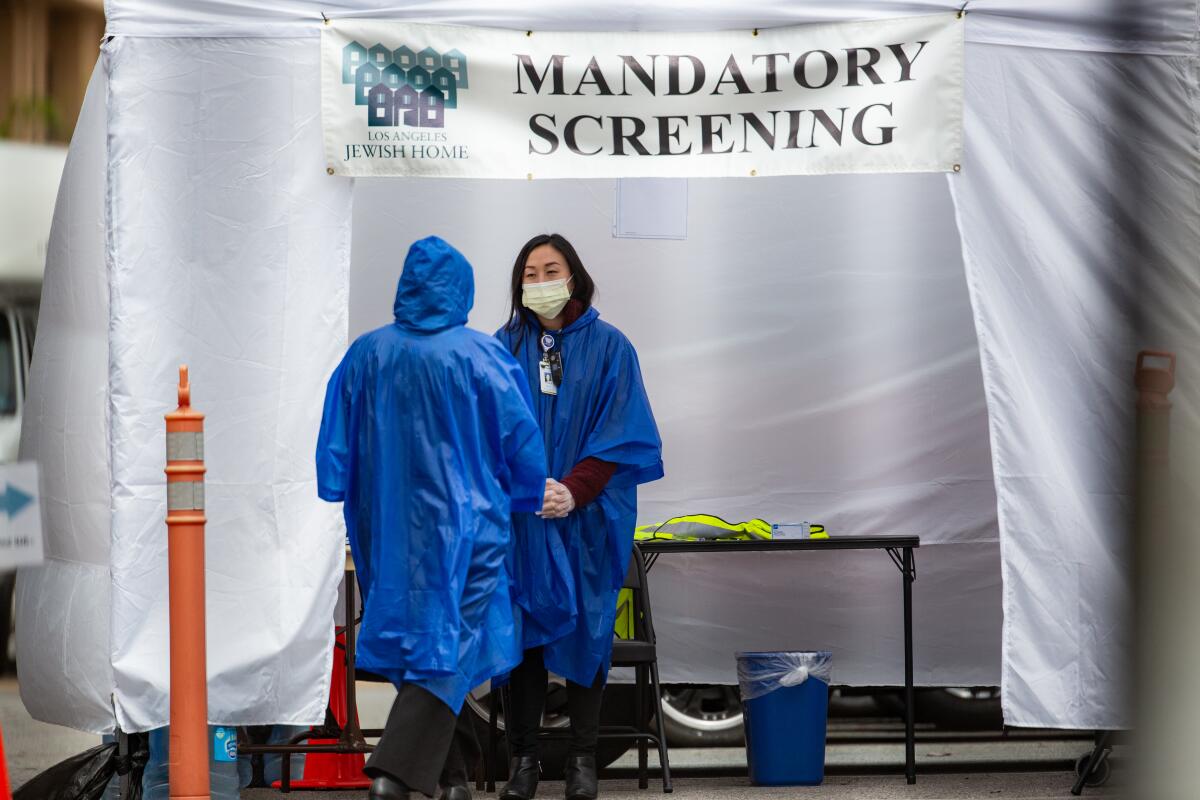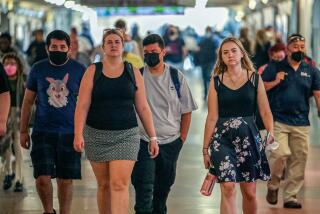Coronavirus outbreaks at nursing homes rise sharply in L.A. County

Los Angeles County officials are investigating coronavirus outbreaks at 11 area nursing homes, where elderly residents with underlying health conditions are among the most vulnerable to the deadly new pathogen.
That’s nearly quadruple the number of nursing home outbreaks county officials had announced on Friday. The county defines an outbreak as three or more cases involving residents or staff at a facility.
The county’s Department of Public Health was also investigating reports of at least one suspected coronavirus infection at seven additional nursing homes as of Monday afternoon. Of the county’s 44 deaths from coronavirus, six were nursing home residents.
The county released the names of all 11 homes with outbreaks, including Kensington Assisted Living in Redondo Beach, Alameda Care Center in Burbank and Silverado Beverly Place in Los Angeles.
“Our investigation teams work with managers at each site to review implementation of infection control, quarantine and isolation protocols,” a Department of Public Health spokesperson said in an email to The Times.
COVID-19 outbreaks are occurring in nursing homes with terrifying speed across the country, with catastrophic potential. One of the first hot spots in the U.S. was at the Life Care Center nursing home in Kirkland, Wash., where two-thirds of the residents and 47 workers fell ill, and 37 people died.
Families with loved ones in nursing homes should seriously consider pulling them out if it’s at all feasible to care for them at home, said Charlene Harrington, professor emeritus at UC San Francisco’s School of Nursing.
“The risk of exposure is so overwhelming,” said Harrington, who has studied nursing homes since the 1980s. “It’s a terrible concern.”
Also concerning to nursing home administrators and physicians is guidance from federal and some state regulators to accept new residents and those returning from hospitals without proof that they are virus-free.
Hospitals in New York are so burdened for space that regulators there ordered nursing homes to take in discharged patients even if they are COVID-19 positive.
Those nursing homes will “do their best, they’ll try to contain it, but people will run out of [protective equipment], caregivers will get sick, and people will die,” said David A. Nace, clinical chief of geriatric medicine for University of Pittsburgh School of Medicine. “New York will have killed people. There’s no way to soften that statement. It’s such a vulnerable population.”
Dr. Michael Wasserman, a geriatrician for more than 30 years and president of the California Assn. of Long Term Medicine, is lobbying California regulators not to follow a similar policy as the number of patients in hospitals rises here.
“If a hospital thinks they are going to save lives by sending a 90-year-old to a nursing home so they can get a 20-year-old on a ventilator, they’re right, they will save a life. But in three weeks they are going to get 30 patients back from the nursing home,” Wasserman said.
Current guidance from the California Department of Public Health advises nursing homes to be prepared to accept patients with the coronavirus from hospitals, and advises the homes to quarantine those patients and make sure staff members have access to protective equipment — which has been in short supply everywhere — and that they are trained in using it.
But that is going to be hard to enforce.
Even before the recent outbreak, Harrington said, there were less-than-ideal conditions at many facilities across the state. Much of the work is done by certified nurse assistants, who have extremely limited training in infection control and are paid minimum wage, Harrington said.
To make ends meet, workers often patch together shifts at two or three different facilities and work even when they don’t feel well.
“They don’t have sick leave, they don’t have health insurance,” she said. “They’re going to come to work.”
And because there isn’t yet widespread testing of all employees across the state, Harrington said, a single, asymptomatic worker could carry the virus into several different facilities, creating an exponential jump in infections.
“It’s a huge, huge problem,” she said, stressing that, even before the outbreak, 75% of the state’s nursing homes were understaffed.
Even high-end homes with no reported cases so far are bracing for the worst.
At the 250-resident Motion Picture & Television Fund home in Woodland Hills, no residents or employees have tested positive, said CEO Bob Beitcher.
“But that could change at any time. I could get a call in the next hour,” said Beitcher. “We all feel like we are living on the knife’s edge. Every time I hear one of these stories it gives me a gut punch.”
He said his residents include people with local families and the means to hire in-home care. Still, he said, no one has pulled a relative out of his facility.
“I think someone is more vulnerable at home than in a place like this,” he said.
More to Read
Start your day right
Sign up for Essential California for news, features and recommendations from the L.A. Times and beyond in your inbox six days a week.
You may occasionally receive promotional content from the Los Angeles Times.









